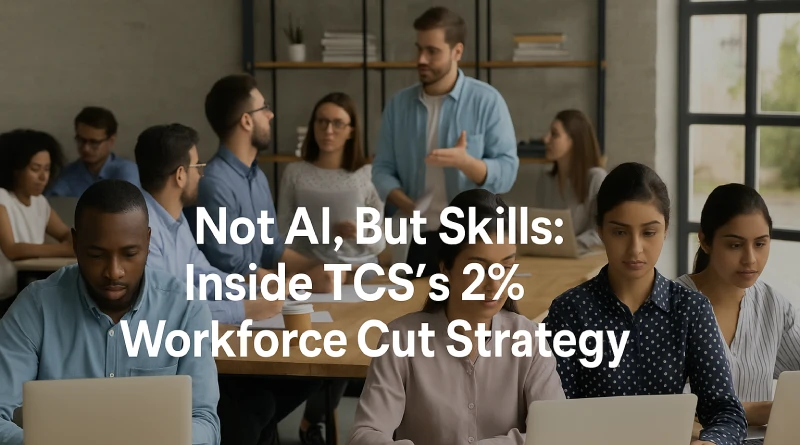Not AI, But Skills: Inside TCS’s 2% Workforce Cut Strategy
On July 27, 2025, Tata Consultancy Services (TCS), an Indian-based information technology (IT) services company, had 2 percent turnover of its workforce, consequently affecting about 12,200 participants by March 2026. In the backdrop of the rumors that artificial intelligence (AI) is suddenly replacing employees, TCS CEO K. Krithivasan explained that the job cuts were not because of the efficiency brought about by artificial intelligence but were rather due to skill shortages and difficulties in deploying employees. This strategic move, which will have been cast with a workforce of 613,069 by June 2025, is to ensure that TCS walks with the changing industry needs and also be considerate of the plight of the employees who are affected by the decision. The article describes the reasoning behind this move of TCS and what this means in respect to the future of the IT industry in India and what one can potentially do about it, drawing upon reputable sources and localizing their application.
The Real Driver: Skill Mismatch, Not AI
AI automation does not directly trigger the layoffs at TCS. Contrary to wide speculations, it is not connected to AI automation. Krithivasan stressed on Moneycontrol that it is not because of AI offering some 20 percent in productivity gain. This is because where we have a skill break, they do it because there is a mismatch in skills, or where we have not been in a position to utilize him or her.” Most reskilling exercises have not necessarily led to redeployment, as occurred in the case of basic AI with 550,000 employees and advanced AI with 100,000 employees. Such functions are traditionally based on legacy systems, such as manual testing or traditional project management, and fail to cover the modern and tech-driven needs.
The transformation of TCS in project management at the expense of the traditional model, which is known as a waterfall project management model, towards agile and product-based structures has also decreased the demand for conventional management positions. In the waterfall models, we used to have a layered leadership. This is changing, Krithivasan says; there is a structural change in the delivery of IT services. The shift is towards more techno-functional talent and fewer non-technical managers, which fits with the expectation of clients in terms of shorter projects with AI integration.
Local Context: India’s IT Industry in Transition
The 283 billion dollar IT industry India is a global powerhouse that is slowly slackening under pressure of economic uncertainties and revolutionary changes in technology. The layoff by TCS, mostly of middle and senior managers, may cause tremors to the key IT centers such as Bengaluru, Chennai, and Hyderabad, where the firm has tens of thousands of employees. As IT professionals act as engines of the local economy (with a decent contribution to real estate, retail, and education), these reductions can demoralize the consumption in cities. To give an example of one city, the IT agriculture of Bengaluru creates direct and indirect employment to the tune of 1.5 million jobs, as per the report of Nasscom 2025.
The downsizing also represents the crisis of skill gaps in India. Aspiring Minds (2024) indicated that the freshly minted engineers’ ability to become high-skill IT workers is below 20 percent despite the 1.5 million engineering graduates that are produced annually. The fact that TCS has a stricter bench policy, where the maximum unassigned time a year is 35 days and people are expected to put in 225 billable days, has been subject to concerns among employees, some of whom have filed legal cases due to its strictness (The Economic Times, 2025). This direction is highlighted by the urgency that professionals should upskill in fields such as AI, cloud computing, and cybersecurity to stay relevant.

Unique Insights: A Compassionate Yet Strategic Overhaul
The strategy of TCS provides a rather intricate image of workforce reformation. As opposed to the heavy-handed cost-cutting strategies, the company is emphasizing mercy, providing severance packages, extending insurance, providing outplacement services, and requiring counseling. The philosophy of Krithivasan, who tries his best to manage layoffs in a very, very compassionate way, is a benchmark of the IT industry in India, where a loss of job is socially unacceptable. It is also considering assignments inside other firms in the Tata group, a unique action that takes advantage of its conglomerate structure.
The last lesson concerns the hiring paradox during layoffs. TCS has hired 5,090 people in Q1 FY26, indicating a strong need for future-ready skills. Krithivasan assured that they will keep looking out to hire good-quality talent, and cuts in the number of people are merciful to deploy, not less manpower requirements. This is a contradictory combination, as in one case job roles are getting cut and in the other they are recruiting AI-empowered jobs, and this is a wider industry trend. According to an analyst, Phil Fersht at HFS Research, the IT companies are “developing junior talent to work with AI solutions” and dropping the services that do not fit into the services-as-software model, which is expected to continue until 2026.
Implications for Stakeholders
For businesses, TCS’s strategy underscores the need to adapt to client demands for agility and cost efficiency. Companies should:
- Embrace Agile Models: Transition to product-aligned, AI-integrated delivery to meet client expectations for 20–30% cost reductions.
- Invest in Reskilling: Partner with platforms like Coursera to train employees in high-demand skills, reducing redeployment risks.
- Monitor Industry Trends: Anticipate similar moves from competitors like Infosys or Wipro, as indicated by Wipro’s planned English competency tests for senior executives.
For employees, the layoffs are a clarion call to upskill. Strategies include:
- Pursue AI Certifications:Enroll in programs for AI, machine learning, or cloud computing, which boost employability by 40% (LinkedIn, 2025).
- Leverage Outplacement: Utilize TCS’s career transition support to find roles in growing sectors like fintech, where hiring is up 15% (TeamLease, 2025).
- Leverage Support: Utilize TCS’s outplacement and counseling services to transition to roles in growing sectors like fintech, where hiring is up 15% (TeamLease, 2025).
- Stay Agile: Build adaptability to navigate shifts in project models and client needs.
Looking Ahead
Layoffs by TCS are not easily solvable, but they provide recalibration of its strategy and guarantee its long-term competitiveness. It would reflect resilience since the company hit a dip of 1.6 percent in Q1 of FY26, or 63,437 crore in revenue, but its net profit was up 6 percent to 6.2760 crore (News18, 2025). Nonetheless, the shift might cause a domino effect, as X users would show a sense of panic: if TCS is retrenching, what would happen to the rest of the IT companies? (@MarathiRojgar, 2025).
Security in the workforce and innovation need to be kept in balance in the IT sector in India. Future disruptions may be enabled by education reforms to ensure that educational curricula meet the industry demands and the government taking steps to facilitate reskilling. To professionals, the memo is straightforward: either upskill or become obsolete. This, of course, is being future-ready, as Krithivasan put it, which is the mantra as far as TCS as well as the IT workforce in India during this revolutionary period are concerned.
Disclaimer
The information presented in this blog is derived from publicly available sources for general use, including any cited references. While we strive to mention credible sources whenever possible, Web Techneeq – Seo Company in Andheri does not guarantee the accuracy of the information provided in any way. This article is intended solely for general informational purposes. It should be understood that it does not constitute legal advice and does not aim to serve as such. If any individual(s) make decisions based on the information in this article without verifying the facts, we explicitly reject any liability that may arise as a result. We recommend that readers seek separate guidance regarding any specific information provided here.

